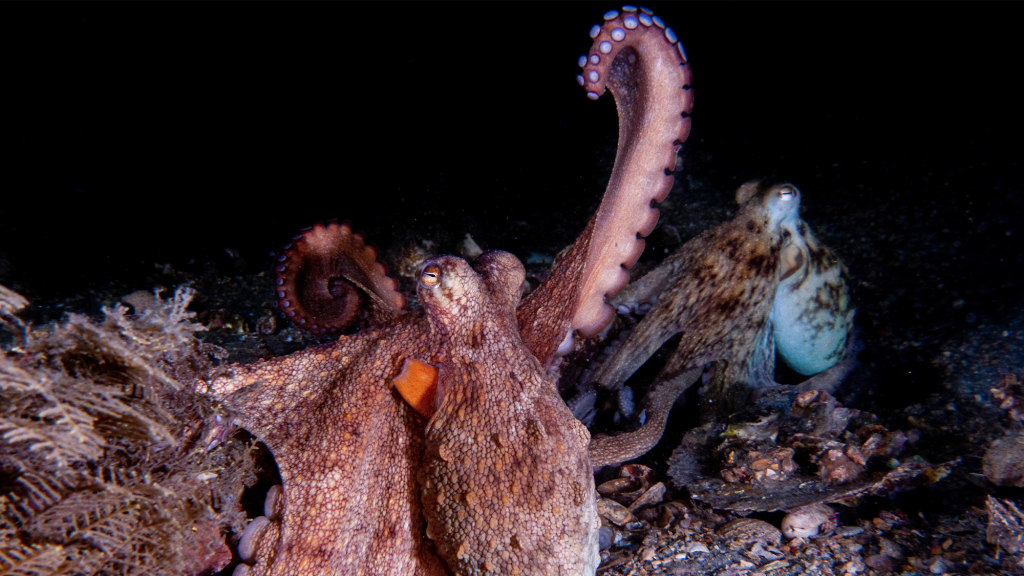With three hearts, blue blood, and eight arms that seem to have a mind of their own, octopuses are among the ocean’s most fascinating creatures. Their signature limbs and complex nervous system help them explore, communicate, capture prey, and mate in many marine habitats. Now, scientists are unlocking some of the secrets embedded in these arms, namely whether they have some degree of “handedness.”
A new study of octopuses in the wild found that all eight arms can do multiple actions, but their front arms are primarily used for movement and exploration, while the back arms are used to support movement. The findings are published today in the journal Scientific Reports.
“Octopuses are ultimate multitaskers–all arms are capable of all arm behaviors and all arm deformations,” Chelsea Bennice, study co-author and a marine biologist at Florida Atlantic University, tells Popular Science. “They can even use multiple arm actions on a single arm and on several arms at the same time.”
A compilation of footage of wild octopuses from the study, displaying a wide variety of the behaviors and actions described in the paper. CREDIT: Chelsea Bennice and Roger Hanlon.
Bend, shorten, elongate, twist
When octopuses move across the seafloor, they can use multiple arms to camouflage from predators. These strong arms are also used for building dens, chucking shells, competing for mates, and more. According to Bennice, all of this flexibility helps the cephalopods to thrive in a wide range of habitats, from sandy shores to rocky reefs.
What is less clear is if particular arms are preferred for one task over another, the way that humans typically have a dominant hand. Currently, limb preference is only well known in primates, rodents, and fish.
“No other animals are capable of such extreme arm flexibility and control,” says Bennice. “Octopuses are unique in that they have eight flexible appendages that can bend, shorten, elongate and twist (arm deformations) in all directions due to the octopus’s extensive nervous system in each arm and the complex arrangement of their arm musculature (and lack of bones).”
[ Related: This magnetic robot arm was inspired by octopus tentacles. ]
To delve into the world of the octopus, the team quantified nearly 4,000 different arm movements from 25 video recordings. The recordings included three wild octopus species observed in six different habitats in the Caribbean and Spain. From the footage, they categorized how the octopuses deployed four main arm deformations–bend, shorten, elongate, and twist.
The recordings showed that the octopuses used all of their arms to bend, shorten, elongate, and twist. However, the regions of each arm had different roles. The tips of the arms were primarily used for bends, while elongations were more frequent closer to the body. So instead of preferring an arm or side the way most humans do, octopuses can use all of their arms for all functions, but do have a slight preference for those up front.

“Importantly, all arms are capable of all functions (arm behaviors), but the front arms are simply used more often than the rear arms (60 percent vs 40 percent),” study co-author and Marine Biological Laboratory biologist Kendra Buresch tells Popular Science. “This is surprising because previous studies have shown particular arm preferences, for example a difference in using left vs right arms–but these studies have mainly been done in the lab.”
This flexibility showcased how well they can control their motor skills and the adaptability of these cephalopods.
“Adaptability is the key feature,” adds study co-author Roger Hanlon, an ethologist and marine biologist also at the Marine Biological Laboratory. “Because they are such tactile creatures, they have evolved suckers and arms that not only give them many forms of locomotion, but sensory capabilities that allow them to find hidden foods when they forage in any eco habitat.”

Future octo-bots
In future studies, the team hopes to compare these findings with other octopus species and their arms.
“Other octopus species have different proportions of arm size and length, and it would be informative to compare their arm behaviors as it relates to the whole animal behavior,” says Bennice.” Examples include octopuses with very long slender arms, such as the mimic octopuses Macrotritopus defilippi in the Caribbean and Thaumoctopus mimicus in the Indo-Pacific.”
Understanding the mechanics behind these exceptional arms can also be applied to neuroscience and could lead to more robots inspired by these adaptable creatures.


